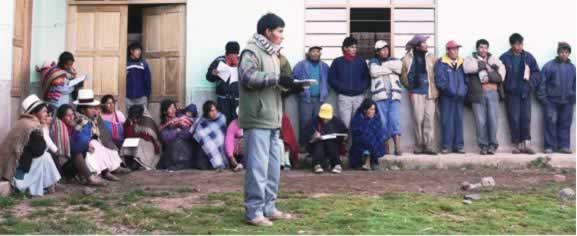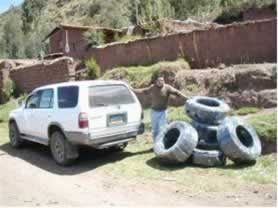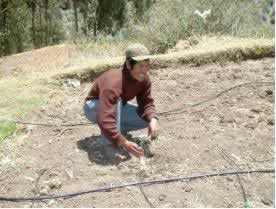|
||||||||
Pumamarka irrigation |
||||||||
| Pumamarka in Cuzco’s San Sebastián district is a typical Quechua-speaking Andean community of 127 families that depends principally on agriculture. It stands out from other rural areas, however, because it lies in the same basin as Saqsaywaman, one of Peru's major archæological sites, and the National Culture Institute, INC, has plans to declare the whole valley of historical importance. As Saqsaywaman itself sadly attests, however, archæological status does not confer guaranteed protection of Peru’s, and humanity’s, extraordinary cultural treasures. But it can help and AA has made its position on the issue clear. The area is striking, also for its beauty and serenity although Pumamarka is only 20 minutes on a dirt road from a bustling and noisy city. And it is here that AA hopes eventually to undertake one of its most ambitious initiatives, the restoration of an abandoned colonial hacienda with Inca remains incorporating sustainable technology See proposal in Spanish. | ||||||||
 |
||||||||
The city of Cuzco is just out of sight,
and sound, in the valley below |
||||||||
| In the first of what we hope will be a series of projects in an area with considerable agricultural and (eco)touristic potential, AA is installing a new irrigation system which community leaders identified as Pumamarka's top priority. The community had wanted to raise water from the valley's stream using a series of electric pumps and reservoirs. AA initially backed the idea and we managed to obtain an undertaking from the local utility to assume 50% of the cost a new electricity line, poles and transformer if the Municipality would also contribute to the scheme. But, as so often, repeated contacts with the local authority were ignored. The lack of response, however, proved fortuitous. On further study AA concluded that if existing springs at higher elevations were used efficiently with ground-level drip-feed or low-flow watering instead of aerial irrigation, a much more sustainable gravity-fed solution could meet all the community's needs without depending on outside energy. | ||||||||
 |
||||||||
Community meeting to discuss the new
irrigation |
||||||||
Still, Pumamarka remained set on using pumps. But Peru's byzantine bureaucracy for once militated in AA's favour. Tapping river water requires approval from the Agriculture Ministry. Erecting poles for electric transmission necessitates a Culture Institute permit. Constructing the powerline would call for agreement between the utility and local government. Overcoming each one of these hurdles could require months. And even if ultimately successful, there were also concerns about the regular payment for the electricity. Many rural communities promise to pay but don't. | ||||||||
 |
||||||||
A segregated discussion of gravity-fed
drip-feed and ‘tubito’ alternatives, samples on ground |
||||||||
| So a gravity-fed drip-feed solution eventually prevailed. Still, this system presents several challenges. Because the apertures through which water is dispensed to individual crops are small and flow rates slow, the water must be very pure or filtered. Good filters are expensive and only work if they are kept clean. Moreover, drip feed hoses cost much more than standard Low Density Polyethylene (LDPE) or Polyvinyl Chloride (PVC) tubing and come in fixed outlet intervals such as every 50 or 100 cm. So we opted for a ‘tubito’ system AA has used in Portugal in which water is delivered through 6 mm tubelets with small taps at each end which compensate for differing distances and flow rates from the source pipe.* In September 2007 installation of Pumamarka's new irrigation system including a pressure regulator for lower elevations began. | ||||||||
|
||||||||
As of early November, 30 plots had been completed. 127 more remain. How quickly we can complete the task will depend on whether we obtain outside funding for the 25,700 dollar balance or must continue to use our own modest resources. 5 November 2007 * AA would be happy to describe the technique and its costs in greater detail to anyone interested. | ||||||||

